|
Vajrasana
(The Diamond Pose) |
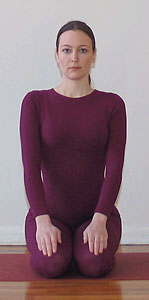 |
Vajrasana is made up of two words, "Vajra" and "Asana". "Vajra"
means thunderbolt. The word "Va" means to move, "Ra" means radiant and
"Asana" means
posture. This means that the Vajrasana radiates blood supply and
subtle energies to upper body. In this asana, you have to kneel
down with legs together, toes pointing out behind you, and sit back on your heels.
The toe touch each other with heels apart, and the spine extends upward. Place
the palm of your hands down on your thighs and look straight ahead.
This asana can be held for long periods of time, or for three to six breaths
like in Supta Vajrasana (forward bend).
Caution
If you have knee strain, place a cushion or folded blanket in the fold of your legs.
|
|
|
|
Supta
Vajrasana |
|
The word "Supta Vajrasana" is made up of two words, Supta and
Vajrasana. Supta means lying down or resting.
In this asana you have to first sit in Vajrasana then inhale, and stretch up from you waist while extending your arms overhead.
Then exhale, bending forward from your hips, keeping your arms next to your ears until your hands rest on the ground.
While inhaling, reverse the path taken into the position, allowing your spine to round.
You can repeat this asana for three to six times. You can remain in this position for three to six breaths,
then return to Vajrasana with hands resting on the thighs.
Caution
Avoid Vajrasana, Mandukasana, and the leg position in Gomukhasana if you have varicose veins or if your knees feel strained.
|
 |
|
|
|
Mandukasana
(The Frog Pose) |
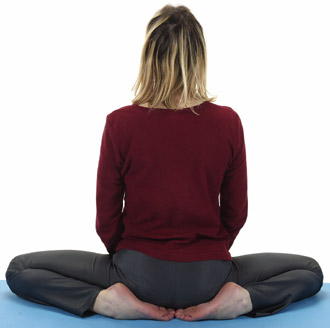 |
Manduka
means frog. Mandukasana means sitting in a frog position. Mandukasana is same as Supta Vajrasana, but
in some ways different. In this asana, you have to spread your knees wide apart while keeping your toes touching. This
asana helps to increase the flexibility in the hips and inner thighs. This
asana also helps in pregnancy.
|
|
|
|
Gomukhasana (The Cow-face Pose) |
|
Gomukhasana
is made up of three words, Go, Mukha and asana. where Go means
Cow, Mukha means face and also means light. So Gomukh also means
lightness of the head.
Moving into the leg position
This asana can be done in two ways. First is moving the
position of the legs and second is moving the position of the
arms. While moving the legs, first of all, kneel down with feet pointing behind you and
hands on the ground directly under your shoulders. Then cross
your right leg in front of your left leg, so that your thighs touch
each other. Sit down between your heels, so that you sit
straight with spine extended then bring your feet as close to your hips
as you can.
Moving into the arm position
While moving the arms, first of all raise your left elbow to point upward, placing your left hand palm down on your back, below the nape of your neck, and centered between the shoulder blades.
Then bring your right hand to take the left elbow as far back behind the
head as you can, keeping your head upright. Then bend your right elbow and twist your forearm behind your back, so that the back of the hand rests against your spine, palm facing out. Hook both hands together, centering them between your shoulder blades
and hold for three to eight breaths. |
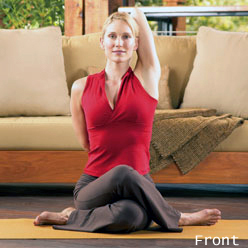 |
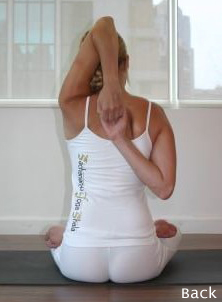 |
|
|
|
Baddha
Konasana (The Butterfly) |
|
Baddha
means bound and Kona means angle, thus this asana can be named as Baddha
Konasana.
In this asana, you have to sit upright with the soles of the
feet together, knees bent and open out to the sides. The spine is extended upward to the head.
Bring forward your feet as close to your body as you can maintain, taking hold of your feet or ankles to help you achieve the position.
You can also do
this asana while sitting on a cushion with straight spine. You
can also use the support of the wall to help you in this posture. Your arms
will also help you in keeping your back straight.
|
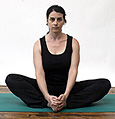 |
|
|
|
Supta
Baddha Konasana |
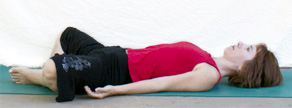 |
In the Supta Baddha Konasana, you have to first sit in Baddha Konasana,
then inhale and imagine as if you are growing taller through your
spine and head.
While exhaling, lean forward from your hips, starting the movement from the lower part of your spine, while keeping the spine extended and head and neck
straight. Then hold your feet or ankles and use them as a leverage to help you bend forward further. Extend your elbows out to the sides and keep pressing your knees down towards the ground. Open your chest area as you hold the posture.
|
|
|
|
Upavista
Konasana (The Straddle) |
|
In the Upavista Konasana, Upavista means in a sitting position and Kona means angle.
In this asana you have to first sit in Baddha Konasana, then straighten and widen your legs
as much as you can, flexing your feet to encourage the
extension of the back of your legs. Place
your hands on the ground in front of you and inhale, extending
your spine upward. While exhaling, lean forward from the hips, keeping your spine
straight and head and neck in line with
the spine. Then bring your hands forward on the ground as far as
you are able to do while maintaining a straight spine. Keep your
weight evenly distributed on both sides of the body. Recover,
starting on inhalation, and reverse the path taken into the
position.
You can also do
this asana while sitting on a cushion. At that time you have to bend your knees slightly
and work towards straightening your legs eventually.
|
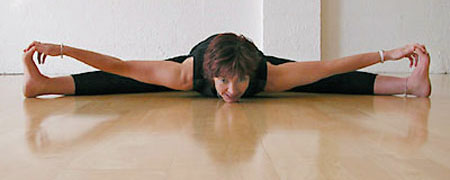 |
|
|
|

